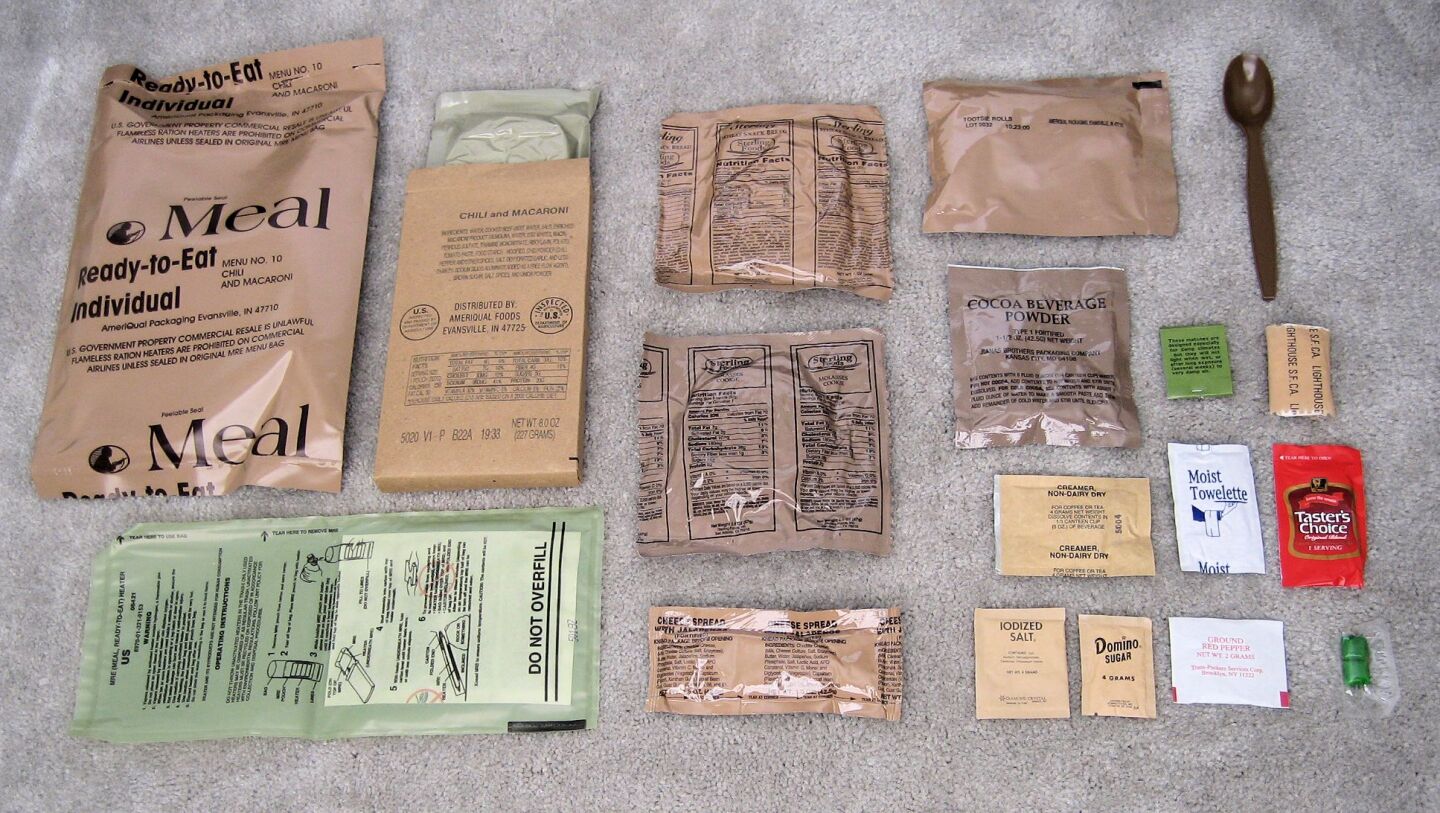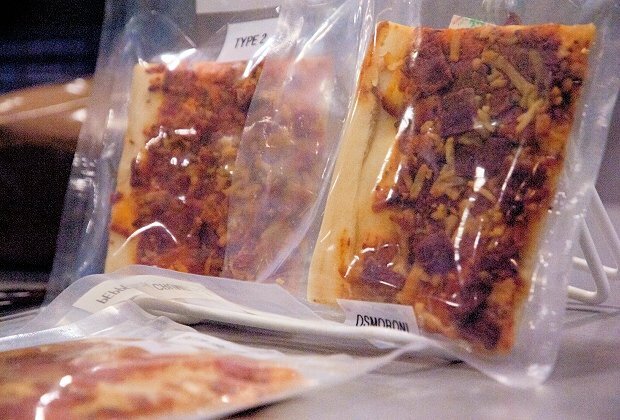Pizza with a three-year shelf life will soon be joining the US Army's field rations menu. These infamous MREs (Meal, Ready to Eat) have a long and checkered history, acquiring such sobriquets over the years as "Meals Rejected by Everyone" and "Materials Resembling Edibles." Pizza has long topped the list of requested meals, but the task of providing a palatable slice of this complex food that will survive the required three-year shelf life has foiled all attempts. Now, the folks at Natick's Combat Feeding Directorate have achieved a minor miracle in food technology: stopping time for a slice of pizza.
MREs are the basis for feeding assault troops engaged in battlefield combat action. Each MRE provides 1300 calories of high-fat, high-sodium nutrition suited for active combat duty.

Individual MREs come sealed in a four-layer plastic pouch measuring about 10 x 6 inches (25 x 15 cm) and weighing about a pound and a half (0.68 kg). The nominal shelf life of an MRE is three years at a storage temperature of 80 ºF (27 ºC), but they must also be able to survive short exposure to temperature extremes from -60 ºF (-51 ºC) to 120 ºF (49 ºC.) MRE packaging must be able to survive parachute deployment from an altitude of 1250 ft (380 m), and a free fall drop from 100 ft (30 m).
Much more difficult than satisfying these physical and chemical requirements, however, is satisfying people's instinctive response to a food. The problem is well known in humanoid robotics, where it is called the uncanny valley.
If the characteristics and behavior of a humanoid robot are very close to those of a natural human, people will accept the robot as an entity that might be a friend. If the approximation of human characteristics is poor, the robot will still be acceptable as a separate, non-humanoid entity. However, if the robot appears close to human norms, but not close enough, the robot will be rejected as strange and dangerous.
People also have an uncanny valley when it comes to food acceptance. It is often easier to come up with a new dish than to try to reproduce one that is enjoyed and valued. A new dish will be evaluated on its own merits, while a reproduction will be compared to an existing standard. For example, a slice of pizza which has a soggy crust and an oversweet taste will be evaluated differently than a sweet tomato bread pudding with cheese and meat topping. It all comes down to expectations, but our expectations can present extremely powerful barriers to surmount.

So how do you make a slice of pizza that will survive three years unrefrigerated that still appears, smells, tastes, and has the mouthfeel of a fresh slice of pizza? Natick senior food technnologist Michelle Richardson took on the task after non-soggy sandwiches entered the MRE choices in the 1990s.
Pizza is a complex food consisting of four major components: bread, sauce, cheese, and sausage (pepperoni in this case). Each of these components has different characteristic levels of moisture, acid, and texture, which must combine harmoniously to produce a slice that will generally be viewed as a "good pizza." In contrast, another combination of bread, sauce, cheese, and sausage made from a hardtack biscuit covered with ketchup, Roquefort cheese, and finely chopped hot dogs won't remind anyone of a good pizza.
Richardson had to reach deep into her bag of tricks to pull off the new pizza. The pizza dough had to be enhanced with humectants, substances like propylene glycol or sorbitol, that bind moisture within the bread. This both reduces the possibility of bacterial growth and the tendency of the sauce to make the crust soggy.
Another problem encountered with bread products is that they go stale with time. Contrary to popular opinion, staling is not caused by the bread drying out (which would be counteracted by humectants). Instead, the moisture in the bread migrates within the bread, causing the starch granules to recrystallize. In the end, Richardson and her assistants used gums and enzymes to hold the water within the starch granules, making the pizza crust shelf-stable.
The challenge with pizza sauce is to keep the moisture held within the sauce, thereby preventing separation of the components and maintaining the sauce's freshness and mouthfeel. A mix of glycerin, rice syrup, and other sugars were used to make the shelf-stable pizza sauce.
For enhanced shelf life, a low-moisture cheese is usually called for. However, one usually expects a pizza to have a reasonably soft, stringy cheese, properties usually not found in low-moisture cheeses. While Natick had used a low-moisture (probably Mozzarella) cheese in other dishes, this cheese became too browned in cooking, making the pizza look burned. This problem was addressed by altering the cooking schedule (time and temperature) and through making blends of various cheeses.
Pepperoni is both fermented and dried, resulting in an acidic, low-moisture sausage that is resistant to most bacterial growth. However, the low pH of pepperoni can encourage mold growth. The result of natural bacterial processes, this is a component which is difficult to control within narrow limits. Beyond the process of making pepperoni, the most important factors in rendering the sausage shelf-stable are osmotic drying and surrounding the pepperoni (and the entire pizza) in a nitrogen atmosphere.

A native of Rhode Island, which has a sizable Italian population, Richardson says she set the bar high: “When I first started developing this, me and my daughter would go and taste pizza because I wanted to use that as my benchmark.”
The Natick pizza MRE is being prepared for final testing. In particular, several types of pepperonis and pizzas are being tested, both for spoilage and for soldier acceptance, to decide what version will make the final cut. We trust it will not disappoint.
Source: US Army







